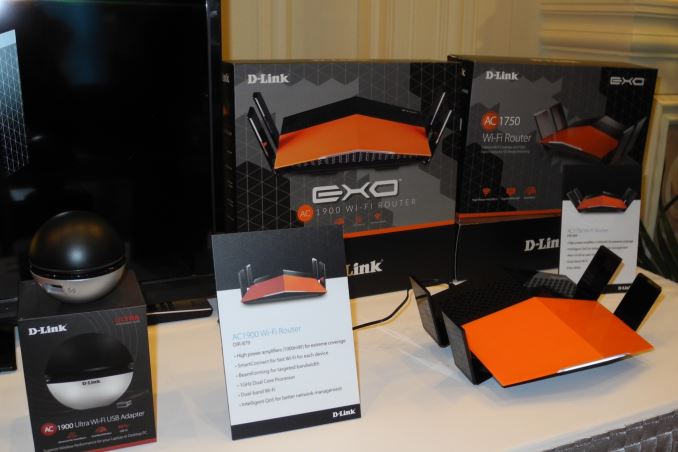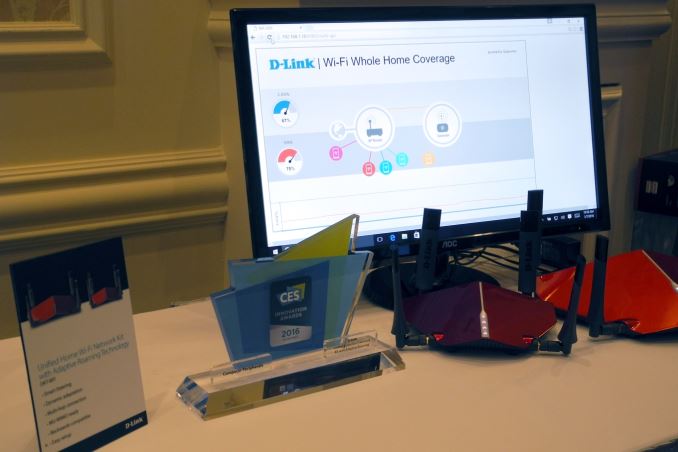D-Link Demonstrates Innovative Networking Solutions at CES
by Ganesh T S on January 18, 2016 10:30 AM EST- Posted in
- Trade Shows
- Networking
- D-Link
- Home Automation
- CES 2016

D-Link had two major core networking announcements at CES along with a host of updates for their home automation product line. There are a number of things to discuss with respect to the core networking announcements. So, I will get the minor home automation stuff out of the way first.
D-Link has been offering a set of home automation products with unified cloud-based control using the mydlink Home app. At CES, they announced the integration of the IFTTT (If-this-then-that) service with the app, allowing more customization in the home automation experience. It is slated to appear in the free app later this quarter. IFTTT integration has been a staple of many home automation products (including the Belkin WeMo) for some time now. So, it is good to see D-Link putting the effort to integrate with IFTTT with their own cloud back-end.
The other home automation-related announcement was a new product - a Wi-Fi based alarm detector. Simply put, this device plugs into a wall outlet and connects via Wi-Fi to the Internet. A microphone in the device is set to trigger an alarm if the sound of a smoke alarm or carbon monoxide alarm is heard. This allows legacy smoke and CO detectors to become part of the smart home - definitely more cost effective than installing completely new smoke alarms (like what Nest suggests). D-Link indicated that, in the future, it might also be able to make the microphones in their IP cameras do the same job.
Moving on to the core networking announcements, we first have the EXO series of routers. This series has two members, the AC1750 DIR-869 and the AC1900 DIR-879. Both have a 3x3 configuration in the 5GHz band for 1300 Mbps of theoretical bandwidth. However, the DIR-879 does 600 Mbps in the 2.4GHz band and the DIR-869 does 450 Mbps in the same. The DIR-869 will retail for $130 and the DIR-879 will retail for $150 when they go on sale later this quarter.
In order to achieve this lower price, D-Link has opted to not integrate a USB port on either model. Both have a hardware toggle switch to move between router and extender modes. However, the devices do have high-performance power amplifiers (1000mW). The interesting aspect here is the core platform. While vendors such as Amped Wireless have gone in for the integrated Qualcomm Atheros 2x2 solution for their $130-price point router, D-Link has moved to Realtek for the same. The SoC used is the RTL8198C with a 620 MHz MIPS-based dual-core host processor and 5 GbE ports integrated. The WLAN chips are RTL8814AR for the 5GHz radio and RTL8194AR for the 2.4GHz radio.
The most innovative demonstration in D-Link's suite was the Unified Home Wi-Fi Networking Kit with Adaptive Roaming Technology (DKT-891). This is a router-extender kit that will retail at $370when it launches in Q2. The DKT-891 consists of two products - the DIR-891L, an AC4300 tri-band MU-MIMO router, and the DAP-1655, an AC1300 gigabit Wi-Fi extender. The DIR-891L seems to be the first tri-band 4x4 router based on a Qualcomm Atheros chipset. With two 5GHz 4x4 radios, each band can support 1733 Mbps (for a total of 3466 Mbps). The 2.4 GHz band can support 800 Mbps with the 256-QAM feature. This gives a total bandwidth of 4266 Mbps, enabling classification as a AC4300 class router. The DAP-1655 provides 867 Mbps in the single 5GHz band and 450 Mbps in the 2.4GHz.
The Unified Home Wi-Fi Networking Kit with Adaptive Roaming is based on Qualcomm's Wi-Fi S.O.N technology (video). At their CES suite, D-Link demonstrated 'Smart Steering' - clients moving from the router to the extender automatically (depending on which one was providing a better signal). They also showed 'Dynamic Adaptation' - clients moving inbetween the 2.4 GHz and 5 GHz bands for load balancing purposes. All of this was done without any end-user intervention. Even though the demonstration looked market ready, it is likely that more 'interoperability' testing will be needed. Getting 'Smart Steering' and 'Dynamic Adaptation' to work across multiple client platforms will definitely be a challenge.
In addition to the above new announcements, D-Link also showed their currently-shipping Broadcom-based Ultra series of routers. the 3x3 DWA-192 USB 3.0 AC1900 WLAN adapter and some IP cameras (including the Komfy switch launched in November).

















14 Comments
View All Comments
Arbie - Monday, January 18, 2016 - link
Installing power-line LAN modules at home completely eliminated all the wi-fi issues I had dealt with for years. I went with Linksys PLE500 devices (PLEK-500 is a kit of two) but guess that other brand names will be about the same. Of course there are use cases where only wi-fi will do, and perhaps in crowded areas the power-line solution might have problems that I don't experience. And it is more expensive since each node needs a module, and you still need a router. But for basic computer networking I think power-line LAN is hugely better than any wi-fi, and worth the cost.ddriver - Monday, January 18, 2016 - link
You still have to be wired, and if you are going to be wired, might as well just put CAT6 cabling - faster and cheaper. Also probably the most secure option, as both powerline and wifi can be compromised from the outside.LordanSS - Monday, January 18, 2016 - link
I thought as much, and when I tried to route wires (so I could pull the cables) through the existing conduits in the house, I realized it wasn't going to happen.I then bought a kit of 2 500Mbps power-line modules, as it was more convenient... but due to, probably, poor wiring and possibly being on different phases, the speed is quite horrendous.
WiFi is not very good because of the brick walls, even though the router is on the office right across the room. I might end up having to drill the walls and ceiling, and put some Cat cables from outside the conduits (not aesthetically pleasing).
Arbie - Monday, January 18, 2016 - link
ddriver: "Wired" means what? Every house is already wired for power-line LAN, at a couple of places in every room. What percent are already wired like that for CAT6? Close to zero. It's obvious that CAT6 is faster and more secure - where it's already installed! What relevant point am I missing in your reply?ddriver - Tuesday, January 19, 2016 - link
Networking has been around for quite a while. Any building constructed or renovated the last 20 years should have network/communication cable installed along with the power lines.brshoemak - Tuesday, January 19, 2016 - link
Many have network cable but aren't terminated for Ethernet. We purchased our home that was built in 2006 from the original owners. It was only wired for phone and terminated to RJ11 jacks, however the builder used CAT5E for the phone lines (which is very common practice anymore). I was able to terminate it both at the wall and into a new patch panel.Having your home 'wired for data' was not as common as you think. Oftentimes it was an overpriced add-on for a home - and most times builders didn't even use conduit. Bastards.
Alexvrb - Tuesday, January 19, 2016 - link
I used to use powerline adapters. Right around the time when a good "N" simultaneous dual-band router was more reliable and faster? I stopped using powerline. I looked into upgrading to a newer powerline setup and it would have cost me more money, and there was no guarantee it would completely eliminate the reliability issues I encountered when running noisy devices (vacuum cleaners, etc). I would have considered using powerline again but they fell behind in terms of speed and wireless AC came out, further increasing the performance gap.Maybe powerline works better in newer homes, or makes more sense in areas where the wireless is crowded (apartments). I've just never had much luck with it myself.
10101010 - Monday, January 18, 2016 - link
Quite a few wifi issues can also be improved using better antennas (if your wifi unit supports external antenna connections). Thinking "outside the house" can also work for some situations, i.e. linking together systems using outside cables.okenny - Monday, January 18, 2016 - link
"and 5 GbE ports integrated"Do you mean 5x 1GBe ports or really 5Gb ethernet ports?
I knew that 5GBe was coming but this would be the first product that I have seen.
DanNeely - Monday, January 18, 2016 - link
5x 1GB ports. Ganesh used identical phrasing in the amped networking article; but that one came with spec sheets. It's your standard 1 up, 4 down config; just like 99% of other consumer routers.